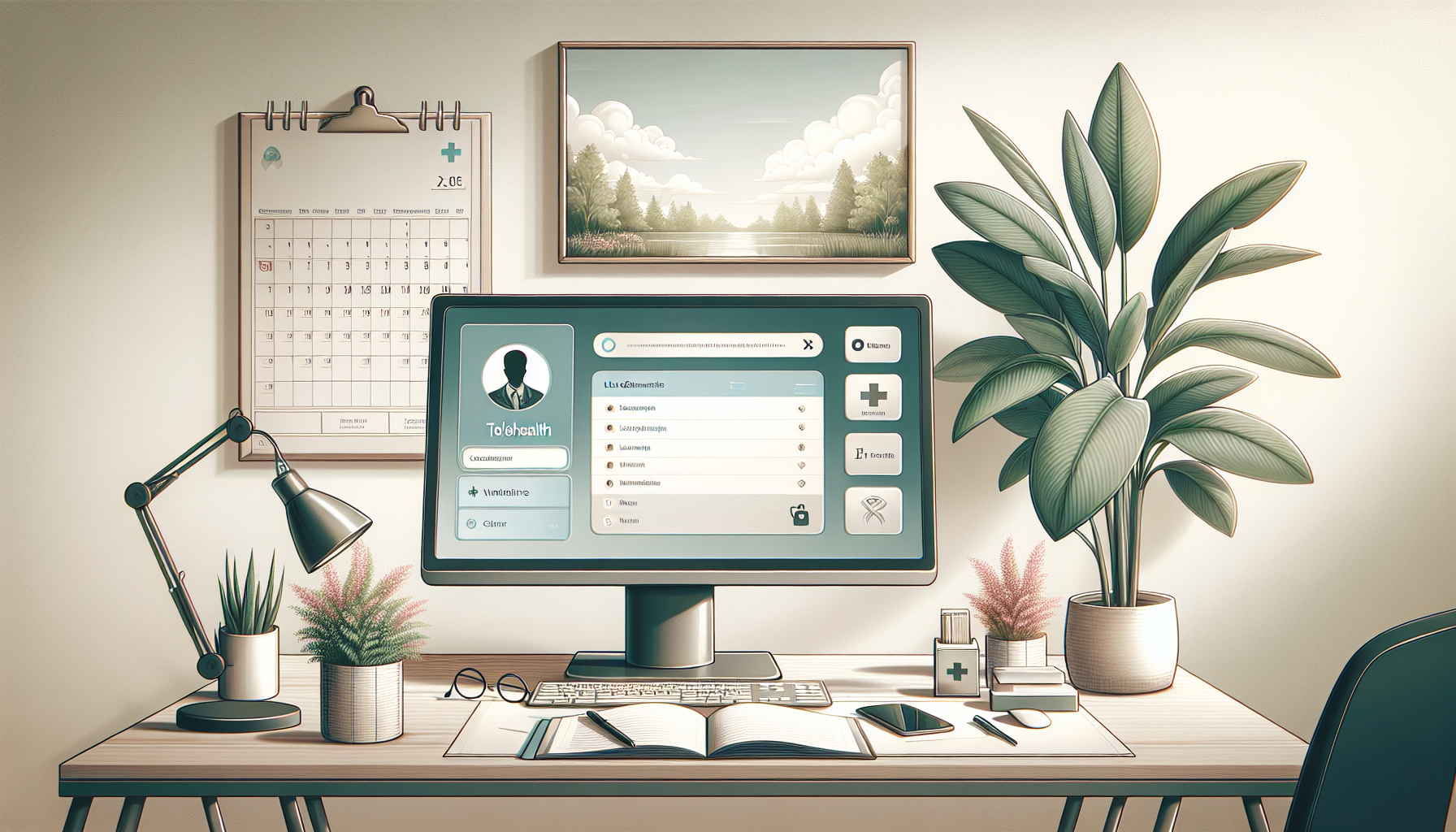Navigating the world of telehealth can feel overwhelming, especially when it comes to communicating with patients effectively. With so many tasks—like scheduling appointments and answering questions—it’s easy to feel like you’re drowning in messages and reminders.
But don’t worry! If you stick around, I’m here to share some fantastic ChatGPT prompts that can streamline your telehealth services and make your life a whole lot easier. Imagine having a handy toolkit that takes care of patient communication, scheduling, and more—all at your fingertips.
From automating appointment reminders to crafting thoughtful follow-up messages, we’ll explore how you can enhance your telehealth practice with the power of ChatGPT. Let’s dive in!
Key Takeaways
- Use ChatGPT prompts to improve communication in telehealth services, making tasks easier and more efficient.
- Automate appointment reminders, pre-appointment instructions, and after-visit summaries to enhance patient satisfaction.
- Implement prompts for scheduling appointments to reduce no-shows and streamline the process.
- Address common patient questions quickly with prepared responses to improve engagement and satisfaction.
- Utilize follow-up messages to maintain patient relationships and promote adherence to treatment plans.
- Enhance patient data collection with effective prompts for intake forms, medical history, and demographics.
- Support remote patient monitoring with daily check-ins and educational resources for better outcomes.
- Focus on mental health support through wellness check-ins and stress management tips to improve patient care.

Top ChatGPT Prompts for Telehealth Services
Using ChatGPT in telehealth can significantly enhance communication and efficiency.
Here are some effective prompts that you can use right away:
- Create a list of potential health concerns for a patient: “List common symptoms and conditions for patients visiting for gastrointestinal issues.”
- Draft FAQs for a telehealth service: “Generate a list of FAQs for new patients using our virtual care services.”
- Summarize telehealth benefits: “Explain the advantages of telehealth for elderly patients.”
- Provide information on insurance coverage for telehealth: “What should patients know about insurance reimbursement for telehealth services?”
Implementing these prompts can streamline your telehealth service communication and keep your patients informed.
How to Use ChatGPT for Patient Communication
Effective patient communication is crucial for successful telehealth services.
Here’s how to use ChatGPT to improve engagement with patients:
- Send appointment reminders: “Draft a friendly appointment reminder for a telehealth session scheduled for tomorrow at 10 AM.”
- Provide pre-appointment instructions: “List the steps a patient should follow before a video consultation with a specialist.”
- Create after-visit summaries: “Summarize the key points a patient should remember after a follow-up appointment.”
Using ChatGPT to automate and personalize these communications can greatly enhance patient satisfaction.
Prompts for Scheduling Telehealth Appointments
Scheduling appointments can be a cumbersome task without the right tools.
Here are some practical ChatGPT prompts you can use to streamline appointment scheduling:
- Generate available times: “Provide available time slots for telehealth appointments next week for a family practice.”
- Confirm an appointment: “Create a confirmation message for a telehealth appointment scheduled for Thursday at 3 PM.”
- Send follow-ups after scheduling: “Draft a follow-up email for patients who have just scheduled their first telehealth consultation.”
Using these prompts can help save time and reduce no-shows, making your scheduling process more efficient.
Using ChatGPT to Answer Common Patient Questions
Patients often have similar queries, making it essential to automate responses wherever possible.
You can use ChatGPT to address common patient questions by using these prompts:
- Explain telehealth technology: “How does telehealth technology work for patient consultations?”
- Clarify medication inquiries: “What should patients know if they have questions about their prescriptions during a telehealth visit?”
- Provide health education: “Compose a brief overview of managing diabetes that I can share with my patients.”
Streamlining these responses helps ensure that patients receive prompt and accurate information, enhancing their overall experience.

Creating Follow-Up Messages with ChatGPT
Follow-up communication is essential in telehealth to ensure patients remain engaged and informed.
Here are some prompts you can use to generate effective follow-up messages with ChatGPT:
- Thank you message after an appointment: “Draft a thank you message for patients who just completed their telehealth consultation.”
- Medication adherence reminder: “Generate a reminder message for patients to take their prescribed medications following their last appointment.”
- Next steps email: “Compose an email outlining the next steps a patient should take after their telehealth visit.”
These prompts help maintain a connection with your patients, promoting better care and adherence to treatment regimens.
Prompts for Collecting Patient Information Efficiently
Gathering patient information is a critical process in telehealth that should be streamlined for accuracy and efficiency.
Utilize these ChatGPT prompts to enhance your data collection:
- Patient intake form questions: “List essential questions to include in a patient intake form for a virtual consultation.”
- Gather medical history: “Create a prompt to ask patients about their medical history during an online appointment.”
- Demographics data collection: “Draft a list of demographic questions to collect from patients before their telehealth session.”
Efficient data collection enhances the accuracy of medical records and improves patient care.
Enhancing Remote Patient Monitoring with ChatGPT Prompts
Remote patient monitoring allows healthcare providers to manage patients’ conditions while they’re at home.
Here are some effective prompts to utilize with ChatGPT for monitoring purposes:
- Daily health check-in: “Craft a message to check in daily with patients regarding their vital signs and symptoms.”
- Alerting changes in health status: “Generate a message for patients on how to report changes in their condition during remote monitoring.”
- Provide educational resources: “Create prompts for sending educational materials related to chronic conditions to monitored patients.”
Implementing these prompts can facilitate timely interventions and improve patient outcomes in a remote setting.
Using ChatGPT for Mental Health Support in Telehealth
Telehealth is an important avenue for providing mental health support, and ChatGPT can assist in many ways.
Consider using these prompts to enhance mental health services:
- Wellness check-in: “Compose a friendly wellness check-in message for patients experiencing anxiety or depression.”
- Tips for managing stress: “Generate a list of stress management techniques to share with patients during their therapy sessions.”
- Encouraging self-reflection: “Draft prompts that encourage patients to reflect on their feelings and experiences after therapy.”
These prompts can foster open communication and provide valuable resources, supporting patients’ mental well-being effectively.

Best Practices for Crafting Effective ChatGPT Prompts
Crafting effective prompts is essential for getting the best results from ChatGPT.
To create prompts that yield useful responses, consider these best practices:
- Be specific: Create prompts that are clear and concise. For instance, instead of saying, “Tell me about headaches,” you can specify, “Explain the common causes and treatments for tension headaches.”
- Use open-ended questions: Try to phrase your prompts to encourage detailed responses. For example, “What lifestyle changes can help manage chronic pain?” will elicit richer information.
- Include context: Providing background within your prompt can help ChatGPT understand your request better. For example, “As a primary care physician, summarize how to explain diabetes management to a patient.”
- Iterate and refine: Don’t hesitate to tweak your prompts. If ChatGPT’s first response isn’t what you expected, try rephrasing or adding more detail to guide the output.
- Test for variety: Experiment with different styles of prompts to see which ones yield the best results. For example, “List five questions a patient might ask about telehealth” could give different insights than “What are common telehealth patient concerns?”
These practices will help you tap into the full potential of ChatGPT and improve your telehealth communication.
Examples of ChatGPT Prompts for Health Care Providers
Having examples at your fingertips can be a game-changer for healthcare providers looking to leverage ChatGPT effectively.
Here are some sample prompts you can use:
- Patient education: “Create a handout explaining the relationship between diet and hypertension for my patients.”
- Referral recommendations: “List the criteria I should consider when referring a patient to a specialist.”
- How to handle patient objections: “Develop a script I can use to address a patient’s concerns about medication side effects.”
- Creating treatment plans: “Outline a basic treatment plan for a patient newly diagnosed with Type 2 diabetes.”
- Promoting services: “Compose a brief introduction I can use to inform patients about our new telehealth services available for follow-up care.”
These prompts can help facilitate communication and ensure organizations can deliver high-quality care efficiently.
Integrating ChatGPT into Your Telehealth Workflow
Integrating ChatGPT into your telehealth workflow can improve efficiency and patient engagement.
Here’s how to effectively incorporate it into your processes:
- Assess current workflow: Look at your existing patient communication and data collection processes. Identify areas where ChatGPT could save time or enhance clarity.
- Determine use cases: Decide which aspects of your workflow will benefit most from ChatGPT use, such as scheduling, FAQs, or follow-up communication.
- Train staff: Ensure that your healthcare team understands how to use ChatGPT effectively. Conduct a workshop on writing good prompts and utilizing AI tools in practice.
- Implement gradually: Start by integrating ChatGPT into one area, like patient inquiries, and evaluate its impact before expanding.
- Solicit patient feedback: Once integrated, gather feedback from patients about their experience with AI-assisted communication and adjust accordingly.
By following these steps, you can ensure that ChatGPT serves as a valuable addition to your telehealth practice.
FAQs
Effective prompts include specific times available for appointments, asking for patient preferences, and confirming contact details. Clear instructions help streamline the scheduling process for both patients and healthcare providers.
ChatGPT can enhance patient communication by answering FAQs, providing appointment reminders, and clarifying health instructions, thus improving patient engagement and satisfaction in telehealth services.
Best practices include being clear and specific, using simple language, and providing context. Testing different prompts helps optimize responses and ensures effective communication with patients.
Healthcare providers can integrate ChatGPT by using it for patient inquiries, appointment management, and follow-up communications, ensuring seamless interaction while reducing administrative workload.
